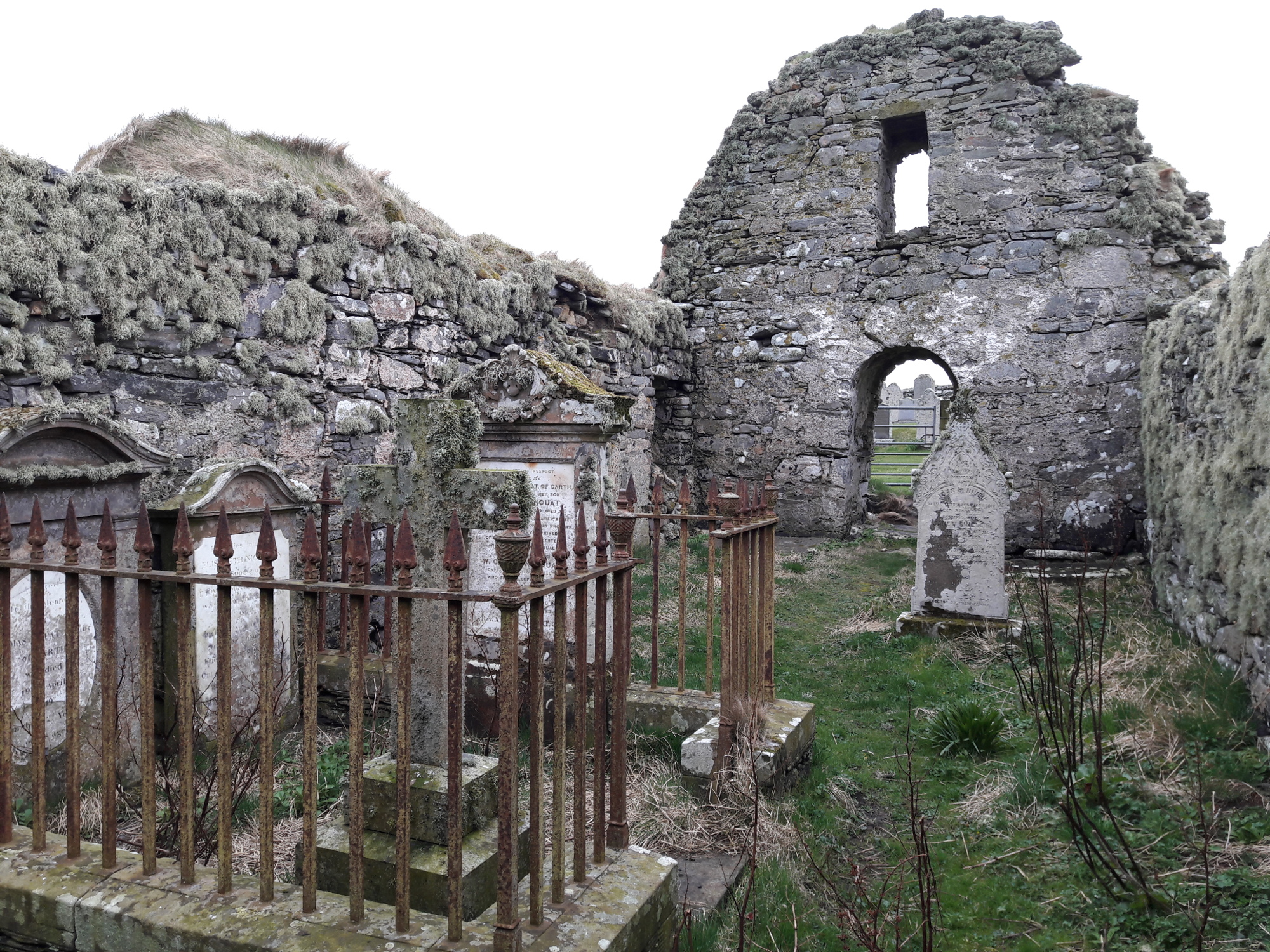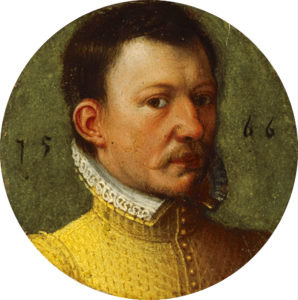A very Cold Case: the Death of Cordt Hemeling revisited
Hans Christian Küchelmann, 6 March 2023
& Hannah Meine
Back in 2016, we wrote on this blog about the peculiar death of Bremen skipper Cordt Hemeling in Shetland in August 1557. Hemeling was lying with his ship in Qualsunt (Whalsay) and was found dead in his bed one morning, ten to twelve days after a fight with two of his crew members. The ship’s carpenter Gerdt Breker, who had injured Hemeling’s hand on that occasion, was subsequently accused of manslaughter, forced to sign a confession of guilt and to pay a compensation to Hemeling’s family. Back in Bremen he raised a court case against this accusation, pleading to be not guilty of Hemeling’s death.
On a summer evening in 2021, I met with a friend of mine, the physician Hannah Meine, and we came to talk about the case. I wanted to know, if the evidence given in the related 16th century documents would allow inferences about the reason for Cordt Hemeling’s sudden and unexpected death, viewed with today’s medical knowledge. Is it possible to die from a hand injury? And as a consequence: was Breker falsely convicted of manslaughter?
For a reliable medical assessment, it is important to know as precisely as possible what happened to the deceased before his death. Luckily, the medical information contained in the documents about the case indeed allows us to narrow down the possible causes of death and to exclude others.
The court case lasted until 1560 and produced extensive records with testimonies about what happened in the summer of 1557 from the defendant, the accusants and of the foud (governor) of Shetland, Olave Sinclair. The original documents are stored at the Staatsarchiv Bremen and an English summary has been published by Ballantyne & Smith (1999, 73-74, 78, no. 110, 118). See also Holterman (2020, 150, 216-218, 224, 357). Transcripts and facsimiles of the documents are available in HANSdoc (Holterman & Nicholls 2018). We will concentrate here only on wordings in the documents shedding light on the constitution of Cordt Hemeling.
According to the witness account of Gerdt Breker, given in the letter of his lawyer Dirick von Minden of 7th of February 1558, there had been increasing tensions between the skipper Cordt Hemeling and his crew for a while:
„Sette und ßegge anfencklick wahr, ock allenn den bewust, de am leschen mit dem schipper Coerde Hemelinck, dem godt gnade, geßegelt hebben, dat he in der tidt, veil unwillenn, mith dem gemenen schepes geßellen, offte deneren gehatt, de mit honischen und troetzegen worden uthgehalet, derhalven ße unvormitlick vororsaket, tho veil malen umme gedachtes schipperen willen, dat schip tho rumende, und sinen moetwillen (umme ein grotter quaet tho vormidende) stede gegeven hebben, is doch zelige Cordt Hemelinck, de schipper, doch vorgedachte gedult der gemenen schepes dener, in ßynem avermode, nicht gestillet, den dagelickes de overhant meir genamen.“
One day, three crew members, the helmsman Evert Barnewolt, the carpenter Gerdt Breker and Alert Wilckens, were sent with a boat (schuete) to Laeß foerde (Laxfirth) to deliver some goods. According to Breker, the unloading took longer than expected for necessary reasons (uth noetwendigen orsaecken) and the crew returned to the ship late in the evening. They were welcomed by the skipper with curses and scolding. When Evert Barnewolt and Gert Breker came aboard, they were both hit by the skipper with a handtspike, a wooden rod used to turn the capstan. Gerdt Breker received a heavy blow in his neck and another one on his back and fell on the ship. He then took a piece of firewood lying around and hit the skipper, injuring two of his fingers. When Alert Wilckens, the third crew member, came aboard, he hit the skipper with a handtspike on the left ear, causing him to fall on the upper deck (averlop):
„[…] de de schipper mith floekende und schelden entfangen, is de stuerman Evert Barnewolt am ersten avergestegen, dar nha de schipper Cordt Hemelingk, mit ener handtspiken geslagen, is em doch under dem slage entfallen. Darnha is averstegen de nhu beklagde Gerdt Brecker, den de schipper mit ener hantspiken hefftich in den nacken geslagen, dat he gestortet is, den anderen slach up den rugge, ock unstummich gedrapen, hefft beklagder do ungever ein barne holt, vor der hant gefunden, dat mede dem schipperen II vinger in der handt, entweg geslagen. Dar nha is ock de derde, Alert Wilckens genompt avergestegen, de den schipperen mit ener hanthspiken ahn dat luchter oer geslagen hefft, alßo dat he dar van de koebruggen is weddergestortet, wert up den averlop.“
(letter of Dirick von Minden 7. 2. 1558).
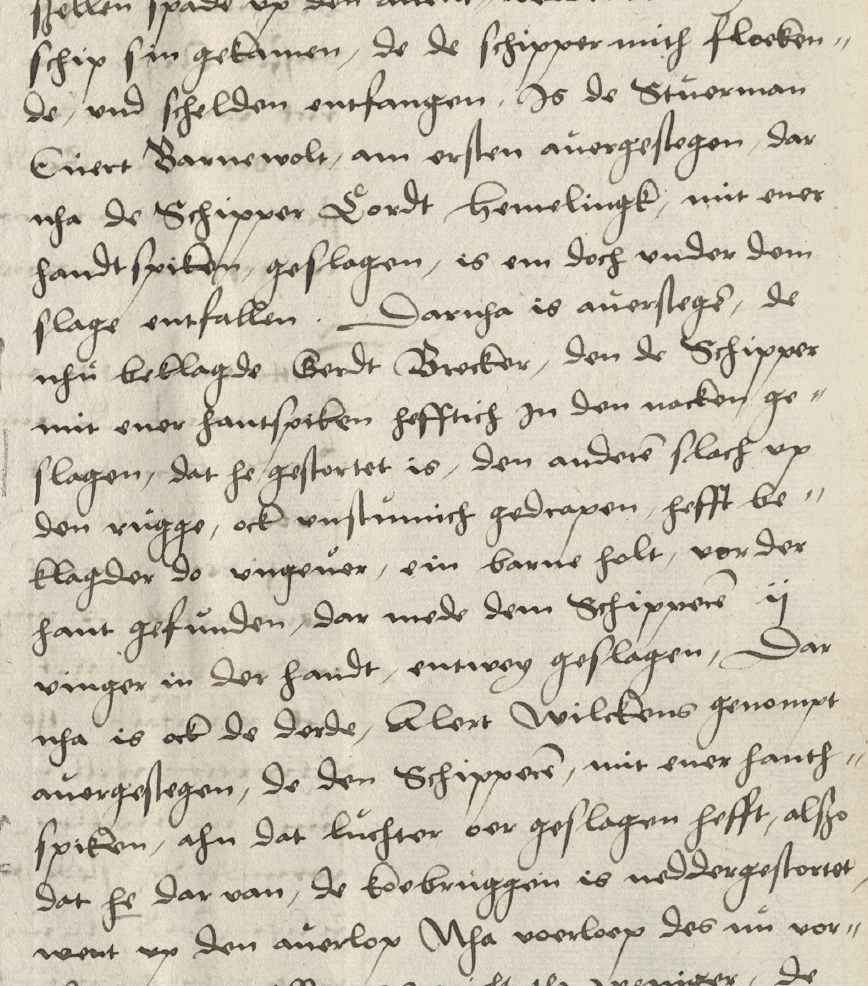
After this incident, the dispute was settled and Cordt Hemeling lived and worked with his crew normally for ten to twelve days, even with the guys he had that quarrel with the other day. He ate with the other merchants, went on the island to buy sheep and constructed a hut and a bed on the island together with his carpenter. He even took part in the work itself, e. g. by nailing. He did not accuse Gerdt Breker of anything, except for the pain of his fingers:
„Nha voerloep des nu vorgedachten unwillen is nicht tho weniger de schipper darnha dagelickes by de 10 offte 12 dagelanck, mit ßinem volcke, ock mith den hantdadigen tho lande gefaren, darmede sampt anderen koepluden gegeten und gedrunckenn, ane jenigen ovell moet, ock tho twen malen sulvest up den eylanden mede geweßen, und schape gehalet, middeler wyle Gerdt Breker nergens mede beklaget, den allene van wegen siner finger ith.“
(Letter of Dirick von Minden 7. 2. 1558).
„Item dat de schypper Cordt Hemelinck selyger darna myth dem folke gegeten unde gedrunken, tho lande unde up de ohe gefaren, dar bygestan, do myn principal de boden up dat landt tymmerde, des gelyken de koien yn der boden, vor den schypper, dar he em ock sulvest thogelanget, wes Gerth tho donde hadde, van nagelen unde anderen.“
(letter of Dirick von Minden 1. 2. 1559).
After ten to twelve days Cordt Hemeling felt weak, reported a headache to the cook and went to bed. The following morning, he was found dead in his bead:
„Do doch midler wille, de schipper up einen avent swack gewordenn, und jegens dem koke aver kranckheit sines hovedes geklaget, und sick dar aver tho bedde gelecht, des anderen morgens is de schipper, dem godt gnade, unvorsendes in ßiner koien doth gefunden.“
(letter of Dirick von Minden 7. 2. 1558).
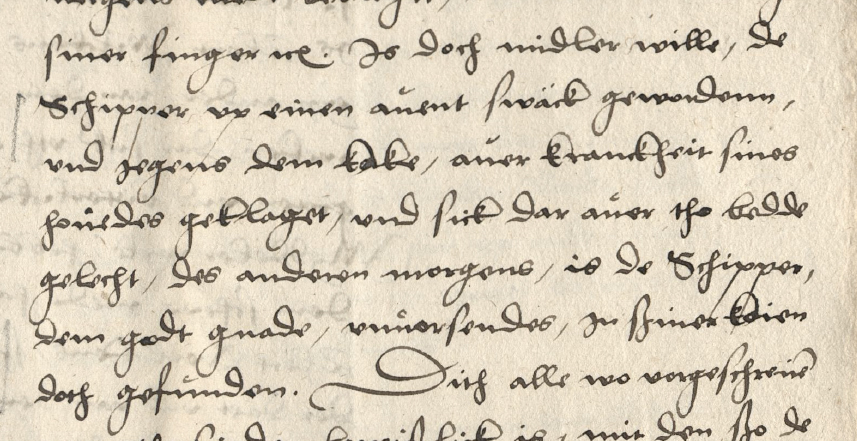
Gerdt Breker claims in his defence that it cannot be proven that the injury he admits to have inflicted upon Hemeling is related to his death:
„Dewile den gebedenden heren, nemandes de dar levet mit warheit kan gudt don, dat de schipper Cordt Hemelinck van dem slage, den em boklagder Gerdt Breker geslagen, gestorven ßy, den hefft dar nha 10 offte 12 dagelanck alle sinen vorigen handell noch gefoert, mith dem nu beklagden, sampt anderen sunder jenigen ovelmoet, gegeten und gedruncken.“
(letter of Dirick von Minden 7. 2. 1558).
His accusers, among them Cordt Hemeling’s brother Gerdt Hemeling, claim that there is no alternative explanation for the cause of death of Hemeling other than that he died from the blow dealt to him by Breker (letter of Gerdt Hemeling 12. 12. 1559). The arguments are repeated several times in the different documents with no further relevant details given, except for two witness accounts describing different kinds of pain. Hermen Schroder reports that Cordt Hemeling complained about pain of the heart, while Diderich Snelle reports of pain of the (left) side of the body:
“dann idt secht Hermen Schroder mynn zelige broder hebbe umme wedaghe des hertenn, unnd Diderich Snelle secht he umme wedage der syden geclaget hebbe.”
(Letter of Gerdt Hemeling 12. 12. 1559).
„[…] dan obwol Hermen Schroder gezeuget, Cordt Hemeling saliger habe den abent vorseinen lesten abscheide umb wehetage deß hertzenn geclaget, unnd Diderich Schnelle saget van wehetage der linckeren seiten, so konen oder mugen dennoch die publicierte attestationes darauß alße streitich keines weges erachtet, noch viel weiniger als undichtich rejiciert und vorworffenn werden, dweile beide wehetage in una eademque parte corporis, und alßo ann einem orde deß leibes befunden, unnd wol geschehen kan, daß ein mensch zugeleich in der seitenn und umbs hertze wehetage habe, unnd dennoich itzt uber die seitenn, dan ubers hertze clage, zu deme da todtlige kranckheit vorhanden, gibt die vernufft und erfarenheit genoichsam, daß als dan daß hertze, welchs gemeinlich in der linckern seiten, und nicht in der rechtern seiten zu sitzen pflecht, am meisten periclitiert, beengestiget und gekrencket wirt. Derhalbenn, wer sagt, daß ehr schmertze umbs hertze habe, der gibt auch zuvormarchenn, daß im die linckern seitenn mit wehetagenn behafftet.“
(Letter of Dirick von Minden 15. 1. 1560).
Do these documents allow conclusions about the cause of Cordt Hemeling’s death from a modern medical perspective? Cordt Hemeling was reported to have been injured on his hand. Since he was apparently able to take part in construction work in the days following the quarrel, including himself nailing, the injury cannot have been more than a spraining or a fracture of a few hand bones. Otherwise he would have been severely impaired in his action. An injury of the hand cannot cause death itself, except in case of a blood poisoning, which could be caused by a wound getting infected with germs. This, however, would have affected Hemeling’s ability to use his hand and his condition would have worsened gradually, including a state of fever. The witness accounts instead report that he was well and acted normally during the days between the quarrel and his death.
Considering the reported chest pain, an illness unrelated to the preceding quarrel could have been responsible for his unexpected exitus. A cardiac infarction or less likely a pulmonary embolism can show symptoms of chest pain. The likelihood of cardiac infarctions raises with age. Unfortunately, we do not know Cordt Hemelings age, but given the fact that he was in command of a ship as a skipper and is included in the book of citizens of Bremen, it is unlikely that he was younger than 30 and might well have been older (see also the blog post about the career of Brüning Rulves).
A rib fracture could also cause chest pain, but is not likely here because it would have resulted in intense pain immediately after the downfall, not with a delay of 10-12 days.
The report of a headache preceding his death could be a hint towards a head injury following the blow with the handtspiken on his left ear or the subsequent downfall on the upper deck. When some venous vessels are ruptured by a heavy concussion, a slow bleeding is possible, which gradually claims space between the brain and the skull bone. Once the brain is crimped too much, the patient becomes drowsy and loses consciousness until death, which might occur even days after the blow to the head was inflicted. The reported 10-12 days between injury and death are a possible timespan for this kind of correlation.
Summarizing the historic evidence, we may look at the case from a juristic perspective. We have to suppose that all witnesses made their testimonies in all conscience. At least neither the other crew members nor the prosecutors contradicted the presentation of the events given by the accused Gerdt Breker. The only discrepancy disputed in the documents is about the kind of pain reported by Cordt Hemeling the night before his death. This discrepancy cannot be solved anymore, but assuming the reported pain was related to his sudden death, both observations medically lead to possible or likely causes of death, which are certainly not related to the hand injury caused and admitted by Gerdt Breker. The argument that there is no possible alternative explanation for Cordt Hemeling’s death, brought forward by the prosecutors (e. g. letter of Gerdt Hemeling 12. 12. 1559) is rather weak, at least in a jurisdiction in which the principle in dubio pro reo should be applied. From the medical perspective, other explanations for this sudden death are definitely possible and likely. Furthermore, a causal relation to the hand injury can be excluded. A cardiac infarction would have been completely independent from the events 10-12 days before the death. A brain bleeding, following a concussion, could have been related to a possible head injury caused by the blow with the handtspiken on Hemeling’s ear or the subsequent downfall on the averlop. This blow was, however, inflicted to Hemeling by Alert Wilckens. It remains rather peculiar why none of the involved parties demanded a closer investigation of the role of Alert Wilckens in Hemeling’s death. While both crew members feared penalty in Shetland initially (see e. g. letter of Dirick van Minden 7. 2. 1558), later accusations concentrated solely on the carpenter, whereas Alert Wilckens was not mentioned anymore in the documents.
One more juristic aspect is relevant here: According to the then valid Hanseatic ship’s law, the skipper had the right to hit his crew members once with his hand or fist as a punishment, but he was not allowed to hit twice, in which case the crew member had the right to defend himself:
“[…] und isset dat de meester eenen slaet he is hem sculdich te verdraghen eenen slach mitter hant oft mitter vust men sloghe men eenen meer he mochte sich wol weren […]”
(Vonnesse van Damme § 20, 14th century; Jahnke & Graßmann 2003, 36;
see also Roles of Oleron of ca. 1266 § 12 and Stadtrecht Hamburg of 1497 Schiffrecht § 20).
Therefore, Breker had the law on his side when he hit Hemeling, but Alert Wilckens’ blow against Hemeling was illegal. Indeed, lawyer Dirick von Minden refers to this law without explicitly stating it, when he claims that Gerdt Breker acted in justified self-defense after being hit twice by his captain:
„[…] myn principal Gerth Breker, Cordt Hemelink seligen, andere nargen den up de hantspiken geslagen, de slach uppe de fynger unde arm gegleden, unde dat de schypper vorhen mynen principal twe slege myth der hantspiken gegeven, dat he dar van gestortet.“
(Letter of Dirick von Minden 1. 2. 1559).
„Deweile dan nhun, auß den ergangenen gezeugnisse, kuntlich und offenbar, daß saliger Corth Hemelinges, von Gerth Breker meinen principalen, nicht doitlich vorwunt gewest, sonder alleine mein principal ex necessaria sui corporis defensione, des vorstorbenen frevel mit einem hantspikenn, auff die vinger unnd arm schlagende geweret …“
(Letter of Dirick von Minden and 15. 1. 1560).
Assuming we would have been medical experts in the court case against Gerdt Breker, we would like to suggest, der hochehrbare und hochweise Rath der Stadt Bremen should follow the plea of the advocacy of not guilty and absolve Gerdt Breker of all accusations related to the death of Cordt Hemeling, reducing the accusation at least to bodily injury maximally.
The technical details given in the documents also allow for some interesting glimpses about the construction of the ship, which are of interest for research upon historical ship building. We will dive deeper into these matters in a separate blog article.
References:
• Ballantyne, John H. & Smith, Brian (1999): Shetland Documents, volume 1, 1195 -1579, Lerwick
• Holterman (2016): Manslaughter in the north? the death of Cordt Hemeling on Shetland, 1557
• Holterman, Bart (2020): The Fish Lands. German trade with Iceland, Shetland and the Faroe Islands in the late 15th and 16th century, Berlin
• Holterman, Bart & Nicholls, John H. (2018): HANSdoc Database, Bremerhaven
HansDoc IDs 15570900SHE00, 15580207BRE00, 15580214BRE00, 15580307BRE00, 15580321BRE00, 15580502BRE00, 15590109BRE00, 15590201BRE00, 15590906BRA00, 15591212BRE00, 15600115BRE00, 15600129BRE00, 15600212BRE00
All documents Staatsarchiv Bremen, 2-r.11.kk., Akten der Hitlandfahrer
• Jahnke, Carsten & Graßmann, Antjekathrin (2003): Seerecht im Hanseraum des 15. Jahrhunderts. Edition und Kommentar zum Flandrischen Copiar Nr. 9, Veröffentlichungen zur Geschichte der Hansestadt Lübeck Reihe B 36, Lübeck
• One of the documents from the court case will be shown in the exhibition “Immer Weiter – die Hanse im Nordatlantik” in the German Maritime Museum in Bremerhaven, from 24 March 2023.
Posted in: General, Sources, Stories
A greasy business: the trade in Shetland butter
Bart Holterman, 18 December 2021
Among the commodities exported from the North Atlantic islands in the late Middle Ages and the Early Modern period, few are as enigmatic as butter. As rents and taxes were partly paid in butter on the islands, they frequently appear as a trade item in the dealings of the authorities or the church with foreign (German) merchants. However, the role of butter in the North Atlantic trade is not well understood.
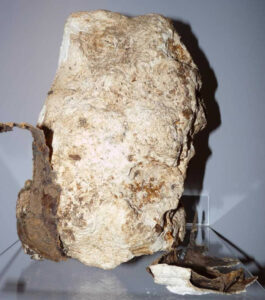
On the Carta Marina of Olaus Magnus of 1539, barrels of butter are displayed near the monastery Helgafell in Iceland, indicating the significant butter production of the Icelandic church (see the header image of this blog). Magnus described in his 1555 Historia de gentibus septentrionalibus that salted butter was produced in Iceland “partly for consumption at home, but more particularly for barter with merchants”. It is indeed known that German merchants bought butter in Iceland, but but they imported butter to Iceland as well, which is puzzling. Probably, this was butter of a different quality, but the sources do not say much about it. Butter exports are also known for the Faroes in the late 16th century.
Where the relevance of butter as a foreign exchange product was probably limited in Iceland and the Faroes, it seems to have played a much more prominent role in Shetland and Orkney. Especially in the 17th century, there are frequent mentions of German merchants buying butter from Shetland sheriffs, lairds or tacksmen. On many occasions, they even entered into considerable debts for taking the butter to Germany.
This is remarkable, given that the export butter from Shetland and Orkney does not seem to have been of a specifically good quality. Farmers kept the better quality “meat butter” for home consumption, whereas the butter with which taxes and rents were paid was the low quality “grease butter”, full of hairs and dirt, unfit for consumption. According to Gordon Donaldson, it “was fit only for greasing wagon-wheels”. It was exactly this grease butter that was sold abroad. Already in the 16th century, it is known that salted Orkney butter was sold very cheaply in Scotland.
On a more closer look, it seems that the German merchants in Shetland were not so keen on buying the Shetland butter, even though they bought it in considerable quantities. Various letters of the 17th century tell about the negotiations of Shetland tacksmen and the servants of lairds with German merchants about the price of butter. For example, James Omand wrote to Laurence Sinclair of Brugh in 1640 that he could only sell the butter to the Germans for a lower price than expected. Two letters from Andro Greig to the Baron of Brugh from 1655 mention his dealings with Hamburg merchant Otto Make, who was not interested in buying butter for the reason that he could not get a good price for it on the German market. The letters of the tacksmen Andro Smith to his brother Patrick from the early 1640s also speak of the difficulties he had with selling the butter to the German merchants; he had to sell the butter in Leith in the end.
Even more explicit is a letter from David Murray to Andrew Mowat from 1682, in which Murray instructs Mowat to “use all possible means” to make the German merchants take the Shetland butter. This included threatening them, although he also presses him “to deall civellie with them”.
All in all, it appears that Shetland officials did not always have an easy time trying to sell the butter abroad. It also remains the questions why the Germans took the butter with them after all, especially since good-quality butter was produced in northern Germany as well, for example in East Frisia. Were the Germans exaggerating and only playing hard-to-get to keep the prices low? Did they give in to the pressure that the Shetlanders put on them? Or did they perhaps feel obliged to take parts of the butter from their trading partners for fear of losing access to the much more profitable Shetland fish trade, even if they could only sell it at a loss? It seems that further research will be needed to solve this riddle.
References and further reading
Ballantyne, John H., and Brian Smith, eds. Shetland Documents, 1612-1637. Lerwick, 2016.
Donaldson, Gordon. Shetland Life under Earl Patrick. Edinburgh, 1958.
Fenton, Alexander. The Northern Isles: Orkney and Shetland. Edinburgh, 1978.
Holterman, Bart. The Fish Lands. German Trade with Iceland, Shetland and the Faroe Islands in the Late 15th and 16th Century. Berlin, 2020.
Posted in: General, Sources, Stories
The enigmatic Icelandic hare, which turned into a sock
Hans Christian Küchelmann, 4 January 2021
Writing about Hamburg trading connections with Iceland in 1899, Richard Ehrenberg mentions cursorily in a footnote that Hamburg merchants received hares from Icelanders (Ehrenberg 1899, 25). He refers to an entry in the donation register of the Annenbruderschaft (confraternity of St. Anne). The Annenbruderschaft was a caritative organisation, for which Hamburg merchants trading with Iceland, Shetland and the Faeroes regularly gave money after returning from their journeys. The account book lists goods bought in Iceland and the donations given as a share to the fraternity for the period 1533-1628. The specific entry concerns the donations of the ship’s crew of skipper Marten Horneman after their journey to Iceland in 1587 and reads:
„item up der Öhe geschattet 15 hovet f und 1 par hasen darvor 5 s“.
(Staatsarchiv Hamburg 612-2/5, Kaufmannsgesellschaft der Islandfahrer, Annenbruderschaft, 1520-1842, 2, Band 1, folio 327r; see HansDoc, document ID 15330000HAM00).
Bart Holterman transcribed and analysed several hundred historic documents relating to Hanseatic North Atlantic trade for his PhD-thesis (Holterman 2020; Holterman & Nicholls 2018), which allows us to decipher the data given in the documents in more detail:
• „Öhe“ is a lower German term for island and since we know from the account book that Marten Hornemann traded in Keflavík (Kibbelwick), Reykjanes peninsula, from 1586-1595 it will have been an island near this trading station.
• „schatten“ is a legal term comparable to a monetary fine, indicating that somebody had to pay a fine for something not further specified.
• „f“ is the shortcut for fish used throughout the whole document. From the overall context we can be almost certain that „fish“ always indicates cod (Gadus morhua) prepared as stockfish. Stockfish made from cod is the bulk item bought by German merchants in Iceland and all other fish species or product types are usually indicated as such separately. We are not yet certain what „hovet fisch“ indicates in particular. „Hovet“ is lower German for „Haupt“ (= main, head, capital), so we assume so far that it is a large kind of stockfish.
• „Hase“ is the German name of the hare (Lepus europaeus).
• „5 s“ specifies that 5 shilling have been given to the confraternity as share of the items received.
• A term that will become crucial in the interpretation is „1 par“. The German speciality with the modern word „paar“ or „Paar“ is that it can have two different meanings. If written with a capital P as „Paar“ it means „pair“ specifying (exactly) two items which are connected to each other, like e. g. a pair of gloves or two people married to each other (Ehepaar). If written with a small p it denotes a small but uncertain number of items: „ein paar Kekse“ being „some cookies“.
Summarised, the information given is that skipper Marten Horneman received 15 (large?) stockfish and some hares as a fine from somebody on an island near Keflavík and gave five shilling to the St. Anne confraternity for this. Further research for hasen in the Iceland trade documents revealed that hasen appear in fact three times in the account book of the Annenbruderschaft in similar contexts:
folio 369 r (1592): “Noch van Jon lochman vor norden den armen gegeven 9 ele min 1 q(uart?) wadtman und 1 par hasen darvan gekamen in gelde.“
folio 398r (1596): “Otte Eddelman 1 par hasen darvor entfangen,“
Jon Lochman is better known as Jón Jónsson, lawmen (ĺögmaður) in northern and western Iceland at the end of the 16th century, who is known to have cooperated closely with German merchants.
Additionally, there is another document, which lists hasen being bought from Icelanders: An account book of merchants from Oldenburg trading 1585 in Neßwage (Nes), Snæfellsnes peninsula, mentions hasen four times:
page 38: “1 paer haesen“
page 38: “1 par haesen 1 fordung […] 1 paer haesen“
page 45: “3 par haesenn up 1 wett“
(Stadtarchiv Oldenburg, Rechnungsbuch über die 1585 in Island verkauften Waren, Best. 262-1, no. 3; Holterman 2020, 45; HansDoc ID 15850000OLD00).
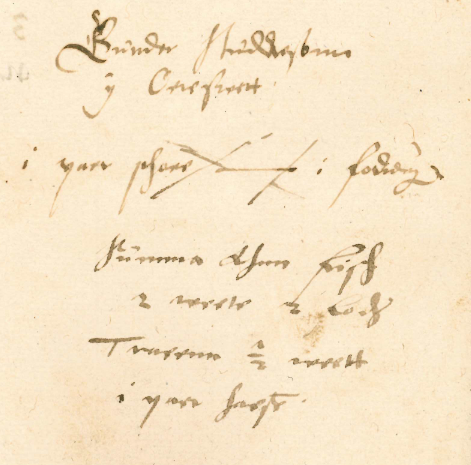

This is a good example for the advantage of interdisciplinary research. From the historic point of view the interpretation here is clear and unequivocally: hares were among the goods bought in Iceland (see Holterman 2020, 45). They were not an item of major importance, but at least appear several times in the 16th century Hanseatic trade in different locations in western Iceland on the Snæfellsnes and Reykjanes peninsulae. From the zoological point of view, however, a major interpretation problem evolves here. According to zoogeographical sources, hares do not inhabit Iceland, neither the European hare (Lepus europaeus) nor the snow hare (Lepus timidus) (see e. g. Grimberger et al. 2009, 211-212, 214-216; see also the list of mammals of Iceland). There are neither archeozoological nor palaeontological records of hares from Iceland, indicating that the genus ever inhabited the island.
Important here, and even more convincing from the historic point of view, is an account of Arngrimur Jónsson from 1593, who states in his “Brevis commentarius …“ that:
“Eodem crimine tenentur, quicunque; Islandiæ, coruos albos, picas, lepores, et vultures adscripserunt: Perrarò enim vultures, cum glacie marina, sicut etiam vrsos (sed hos sæpius quam vultures) et cornicum quoddam genus, Islandis Isakrakur, aduenire obseruatum est. Picas verò et lepores, vt et coruos albos, nunquam Islandia habuit.“
(Jónsson 1593, sectio 14, quoted after Hakluyt 1598).
Jónsson refers to the description of a not specified author, who claims the mentioned species (white ravens, magpies, hares and vultures) as resident species of Iceland. He is very precise in his comment and disclaims this notion clearly as being wrong, except for vultures, which sometimes reach Iceland with the sea ice. Thus, zoological, archaeozoological and additional historic evidence points to a wrong interpretation of the Low German term hasen as hares here. However, there is one slight possibility that needed to be cross-checked before refuting hares and searching for alternative interpretations. One species frequently mistaken for hares, at least by non-specialists, is the rabbit (Oryctolagus cuniculus). Rabbits spread in Europe from the 12th century onwards, first as gifts changed between monasteries. They were high status animals first, jealously guarded by monastic circles and the gentry, becoming more widespread since the 16th century (Benecke 1994, 356-361; Küchelmann 2010, 183-184). Therefore, an introduction of rabbits to Iceland in medieval or early modern time is theoretically not impossible. I am grateful to Lísabet Guðmundsdóttir (Institut of Archaeology Reykjavik), who kindly checked this question:
„Rabbits are a modern intrusion to Iceland, being imported as pets, which were let loose, mostly around Reykjavík but they have also become an ecological problem in Vestmannaeyjar since they are using puffin holes as habitation and the puffins usually use the same ones again and again. They are also living in areas around Akureyri at present. The oldest example of “wild” rabbits in Iceland (that I know of) is from 1942, a farmer in Saurbjæjarhlíð in Hvalfjarðarströnd started to breed rabbits around 1932 but some had gotten away and had started to breed in the wild at least in 1942 (see Morgunblaðið 7.3.1942). Rabbits had been imported earlier to Iceland but had never been able to survive the winters but now they can. At present the numbers of them are rising instead of declining which is not good since they are causing havoc to the quite sensitive Arctic environment.“ (Guðmundsdóttir, personal comm. 16. 11. 2020).
Summarising the historical and zoological information, it seems unlikely that hares could have been bought by the Hanseatic merchants in Iceland. Even the slight possibility of introduced rabbits is extremely unlikely. Reanalyzing the historic accounts and searching for alternative interpretations the above mentioned word „par“ becomes important. In all seven evident cases of the term „hasen“ bought in Iceland, they appear in combination with the word „par“. They never occur as single items (1 hase) nor in an uneven number (e.g. 3 or 5 hasen). This makes it likely that in this case „par“ does not mean an uncertain small number of hasen, but that instead hasen are a good regularly traded in pairs. The most probable solution here is that of a sound shift from o to a. „Hosen“ is the German term for trousers, which then would make perfect sense as a „pair of trousers“. Indeed, there is historical evidence for a sound shift from o to a in several Middle Low German words related to hosen, which are listed e. g. in the Middle Low German word books of Köbler (2014) and Schiller & Lübben (1876/1995, 212, 305-306). Vaðmal and trousers – two textile goods – donated by Jón Jónsson in 1592 would also fit well together. The term „1 par hasen“ also appears in another document related to Icelandic trade: The account book of the Bremen merchant Clawes Monnickhusen, who traded 1557-1558 in Kummerwage (= Kumbaravogur, Snæfellsnes), lists hasen two times. But here the hasen appear in that part of the document listing debts of his customers in Bremen 1560-1577. The hasen again are listed as pairs, adding weight to the argument of a sound shift:
folio 24r (1571): „Item den man dar ick den ossen van krech XV grote vor I par hasen.“
folio 30r (1575): „Item Devert Jebelman I par hasen XX grote.“
(Staatsarchiv der Freien und Hansestadt Bremen 7,2051 (formerly Ss.2.a.2.f.3.a.), HansDoc ID 15570000BRE00).
To conclude, the former interpretation of the term hasen as the zoological species Lepus can be refuted, but the entries then become an interesting evidence for Icelandic textile production and trade. According to Michèle Hayeur Smith, researcher on historic textiles at the Haffenreffer Museum of Anthropology, Brown University, Bristol, Rhode Island, USA, the trousers bought by the Hanseatic merchats in Iceland most probably were knitted stockings:
„In the 16th century they were in the habit (in Europe) of wearing long knitted stockings, in fact it was all the rage. Knitting was introduced into Iceland in 1500 and I know that the Icelanders and Faroese were busy knitting for these foreign markets and one of the main things they were knitting were stockings. I think that we are probably not talking about hosen as trousers, but rather as stockings and sold in pairs would make a lot of sense.“ (Hayeur Smith, personal comm. 17. 11. 2020).

For further research on Icelandic knitted stockings see e. g. Thirsk (2003), Róbertsdóttir (2008) or Hayeur Smith et al. (2018, 5).
References:
• Benecke, Norbert (1994): Der Mensch und seine Haustiere, Stuttgart
• Ehrenberg, Richard (1899): Aus der Hamburgischen Handelsgeschichte, Zeitschrift des Vereins für Hamburgische Geschichte 10, 1–40
• Grimmberger, Eckhard / Rudloff, Klaus / Kern, Christian (2009): Atlas der Säugetiere Europas, Nordafrikas und Vorderasiens, Münster
• Hakluyt, Richard (1598): The Principal Navigations, Voyages, Traffiques and Discoveries of the English Nation, v. 1, Northern Europe
• Holterman, Bart (2020): The Fish Lands. German trade with Iceland, Shetland and the Faroe Islands in the late 15th and 16th century, Berlin
• Hayeur Smith, Michèle / Lucas, Gavin / Mould, Quita (2018): Men in Black: Performing masculinity in 17th- and 18th-century Iceland. – Journal of Social Archaeology 0(0), 1-26
• Holterman, Bart & Nicholls, John H. (2018): HANSdoc Database, Bremerhaven
• Jónsson, Arngrímur (1593): Brevis commentarius de Islandia
• Köbler, Gerhard (2014): Mittelniederdeutsches Wörterbuch, 3. Ausgabe, Erlangen
• Küchelmann, Hans Christian (2010): Vornehme Mahlzeiten: Tierknochen aus dem Dominikanerkloster Norden. – Nachrichten aus Niedersachsens Urgeschichte 79, 155-200
• Róbertsdóttir, Hrefna (2008): Wool and society, Reykjavík
• Schiller, Karl & Lübben, August (1876/1995): Mittelniederdeutsches Wörterbuch, Zweiter Band: G–L, Vaduz
• Thirsk, Joan (2003): Knitting and Knitwear, c 1500-1780. in: Jenkins, David (ed.): The Cambridge History of Western Textiles I, 562-584, Cambridge
Posted in: General, Sources, Stories
Till death do us part: Graves of sixteenth-century German merchants in the North Atlantic
Bart Holterman, 11 October 2018
When one has the chance to visit the northernmost island of Shetland, Unst, it is worth visiting the ruined church at Lunda Wick, in a bay to the Southwest of the isle. To get there, one has to take a small gravel road across a barren moory landscape where nothing seems to live but sheep and the occasional marsh bird. At the end of the path, one reaches a secluded bay where the grey waves and the rain torture the sands of the beach, and out of the fog a ruined medieval chapel appears with a graveyard around it. Inside the roofless chapel are a number of old tomb stones, the text made almost illegible by the lichen that overgrows them and centuries of rain and salty sea wind. In a corner lies a grave slab, on which it is possible to discern a text written in Low German, with great difficulty: “Here lies the honourable Segebad Detken, citizen and merchant from Bremen, who has traded in this country for 52 years, and died [in the year 1573], the 20th of August. God have mercy on his soul” (see below for the Low German text).
Segebad Detken is known from written sources about the Bremen trade with Shetland. He can be tracked from 1557 onwards as a skipper in the northern harbours Burravoe in Yell, and Baltasound and Uyeasound in Unst. In 1566, he was robbed by Scottish pirates in the harbour of Uyeasound. As his tomb slab mentions that he had been trading for 52 years in Shetland, he must have died in the late 16th century (see below). After his death, his relatives took over the business: among others his son Herman and grandson Magnus are recorded as merchants in northern Shetland in the early 17th century.
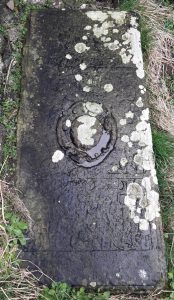
The grave slab of Segebad Detken in the ruined church in Lunda Wick. Photograph: Bart Holterman, 2018.
Given the long careers of German traders in the North Atlantic, and the fact that Bremen and Hamburg merchants dominated this trade for over 100 years (for Shetland even longer), it is not surprising that some of these merchants were buried on the islands when they died there. We can find another example just a bit outside the same church. There is another grave of a contemporary of Segebad Detken, that of his fellow citizen Hinrick Segelken. The Low German text on his slab translates as: “In the year 1585, the 25th of July, on St James’ day, the honourable and noble Hinrick Segelcken the Elder from Germany and citizen of the city of Bremen, died here in God our Lord, who has mercy on him.”
The tombstones were most probably imported by the German merchants, as the sandstone from which they were made is not available on the islands. By erecting a distinct grave marker for their deceased colleagues, they did not only honour their remembrance, but it also served to strengthen their ties with the local communities. The material and textual aspects of the monuments reminded the observer of the importance of the German merchants for the local economy, even across the boundaries of life and death.
A similar situation we find on Iceland, where we can also find tombstones of German merchants. The National Museum of Iceland in Reykjavik, for example, houses the tomb slab of Bremen merchant Claus Lude (follow link for an image), who was originally buried in the monastery Helgafell on the Snæfellsnes peninsula. The stone shows his house mark, a seal with two crossed stockfishes, and a text which mentions that he died on 3 June 1585. Lude is known to have been active in harbours in Snæfellsnes in the 1550s, and held a license for the harbour Grindavík in 1571.
In southern Iceland, at the graveyard of the former monastery Þykkvabær, one can still find the tombstone of Hans Berman the Younger from Hamburg, who died in 1583. The monastery records reveal that he was administrator of the monastic property (klausturhaldari) and was killed by the parish priest of Mýrar. His name also appears in the register of the Confraternity of St Anne of the Iceland merchants in Hamburg, where another Hans Berman (probably his father) was elderman around the same time.
In Hafnarfjörður near Reykjavík, the Hamburg merchants had their headquarters and also erected their own church. It is likely that they also had a graveyard where they buried their dead. During construction of the modern harbour of Hafnarfjörður in the 1940s, human bones were found which many believed to be from the old German graveyard in the town. It might even be possible that these bones once belonged to Hamburg merchant Hans Hambrock, the only death of a Hamburg merchant in Hafnarfjörður known from the written record. Hambrock had died from the injuries inflicted upon him by his colleague Hinrick Ratken, who drew his knife against him after Hambrock had hit Ratken on the head during a conflict about the unloading of a ship in 1599. Regrettably, the remains of the German church in Hafnarfjörður are now buried below the modern town.
Inscriptions on the discussed tombstones
Lunda Wick, Shetland
Segebad Detken: “HIR LIGHT DER EHRSAME / SEGEBAD DETKEN BVRGER / VND KAUFFHANDELER ZU / BREMEN [HE] HETT IN DISEN / LANDE SINE HANDELING / GEBRUCKET 52 IAHR / IST [ANNO 1573] DEN / 20 AUGUSTI SELIGHT / IN UNSEN HERN ENT / SCHLAPEN DER SEELE GODT GNEDIGH IST.”
Hinrick Segelcken: “ANNO 1585 DEN 25 IULII / UP S. JACOBI IS DE EHRBARE / UND VORNEHME HINRICK / SEGELCKEN DE OLDER UTH / DUDESCHLANT UND BORGER / DER STADT BREMEN ALHIR / IN GODT DEM HERN ENTSCHL / APN DEM GODT GNEDICH IS.”
Helgafell, Iceland
Clawes Lude: “Anno 1585 de.3. Junius starff clawes lüde van Bremen der olde. Dem godt gnedich seij.”
Þykkvabær, Iceland
Hans Berman: “HIR LICHT BEGRAVEN SALICH HANS BIRMA[N] D:I:V:H [i.e. “De Junger van Hamborg”] ANNO 1583.”
Further reading
Hofmeister, Adolf E. Sorgen eines Bremer Shetlandfahrers: Das Testament des Cordt Folkers von 1543. Bremisches Jahrbuch 94 (2015): 46–57.
Holterman, Bart. The Fish Lands. German Trade with Iceland, Shetland and the Faroes in the Late 15th and 16th Century. PhD thesis, Universität Hamburg, 2018.
Koch, Friederike Christiane. Das Grab des Hamburger Hansekaufmanns Hans Berman/Birman in Þykkvibær/Südisland. Island. Zeitschrift der Deutsch-Isländischen Gesellschaft e.V. Köln und der Gesellschaft der Freunde Islands e.V. Hamburg 5.2 (1999): 45.
MacDonald, George. More Shetland Tombstones. Proceedings of the Society of Antiquaries of Scotland 69 (1934): 27–48.
Wrong place, wrong time: the theft of Gerdt Hemeling’s ship on Shetland, 1567
Bart Holterman, 28 September 2016
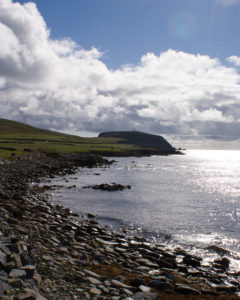
Sumburgh Head (Sweineburgkhaupt), the southern tip of Mainland, close to which the harbour must have been which was used by Gerdt Hemeling. Image: Wikimedia Commons
In the early months of 1568, Bremen merchant Gerdt Hemeling (the brother of the deceased Cordt Hemeling, about whose death we wrote in an earlier blogpost) complained to king Frederick II of Denmark about the theft of his ship in Shetland by a “Scottish man”. This man had promised to return his ship, or to compensate him for it, but was taken captive by Danish officials and was now in prison in the castle of Bergenhus in Bergen, Norway. Now Hemeling, a “poor and extremely desperate man”, appealed to the Danish king to compensate him for the loss of his ship and his goods, which had been thrown overboard when the ship was taken, and most of which he had to leave on the shores of Shetland.
Gerdt Hemeling had traded peacefully for years between Bremen and Shetland, staying on the islands every summer to trade commodities from mainland Europe for fish. In the summer of 1567, however, this happened to be just the wrong time and place. While he was loading his ship the Pellicaen with fish in the harbour of “Ness in Schweineburgkhaupt” (probably Dunrossness near Sumburgh head, the southern tip of Shetland Mainland), a ship appeared from Scotland with a few hundred men on board, who offered Hemeling to buy his ship or to rent it for two months. Hemeling claimed to have had no choice but to accept this offer. The men from Scotland threw all merchandise on the shore and left, never to be seen again.
Gerdt Hemeling’s case was in itself not unique. Piracy on German merchants on Shetland occured more often, especially in these years. In the previous year (1566) the Shetland merchants from Bremen filed an official complaint to the city council in which they stated that at least six of them had become the victims of robbery. Scottish pirates had attacked their ships and trading booths and stolen their merchandise, money, weapons, and sailing instruments, to a calculated total damage of 1008 thaler. Two of the pirates’ captains, James Edmistoun and John Blacader, were arrested and executed the next year by the Scottish authorities.
Gerdt Hemeling, however, found himself in a much more complicated situation. The “Scottish man” turned out to be none other than James Hepburn, 4th earl of Bothwell, an opportunistic nobleman who played a rather controversial role in high politics of his time. In 1567, when Hemeling accidentally met him, Bothwell was a man on the run. He was suspected of having murdered the second husband of Mary Stuart, Queen of Scots, of having kidnapped her (possibly with her own consent), and subsequently married her. Among the Scottish nobility, tensions with the catholic queen had risen in previous years, among others about religious matters, and Mary’s marriage to the protestant alleged murderer of her previous husband proved to be the limit. A coalition of nobles revolted, and faced Mary’s army in the battle of Carberry Hill. Mary eventually surrendered and was imprisoned, finally leading to her abdication, but Bothwell fled and tried to leave Scotland by ship to Shetland.
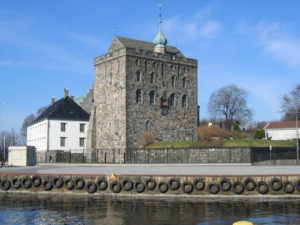
Bergenhus castle, Bergen, Norway. The so-called Rosenkrantz tower was constructed in the 1560s by Erik Rosenkrantz. Image: Wikimedia Commons.
However, Bothwell was being followed by two Scottish lords who controlled the navy. In these chaotic circumstances, Bothwell lost one of his ships which struck an underwater rock, and desperately tried to acquire more ships for his fleet in Shetland. Luckily for him, every year there were a few German trading ships in Shetland, and thus he took Gerdt Hemeling’s ship and another one from Hamburg. However, he was not able to get rid of his persecutors, and a battle resulted in which the mast of one of the ships broke.
A storm subsequently forced Bothwell’s fleet to sail towards Norway, where he was first held for a pirate, taken captive, and locked up in Bergenhus castle by Erik Rosenkrantz, the governer of Bergenhus. When his true identity became known, Frederick II realised the potential of Bothwell in Danish captivity as a pawn when dealing with the English and Scottish crown, and had him transported to Denmark. Bothwell (who had been made duke of Orkney and Shetland by Queen Mary) promised to return these insular groups (which Christian I of Denmark and Norway had lost to Scotland in 1469 as a pawn for the dowry of his daughter to the Scottish king, which he had been unable to pay) to Denmark if the king helped him to free Mary. The Danish king never made use of this offer: Bothwell was locked up in Dragsholm castle, where he would eventually die in 1578.
And did Hemeling ever get his ship back? Frederick II was unwilling to help Hemeling directly, but stated to him twice that he could press charges against Bothwell in Denmark if he wanted to. There are no sources pertaining to a case of Hemeling against Bothwell, so it is likely that Hemeling realised that a lawsuit in Denmark in such a complicated situation would not be worth the trouble, and he must have accepted his loss.
